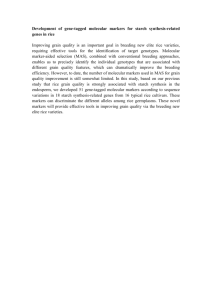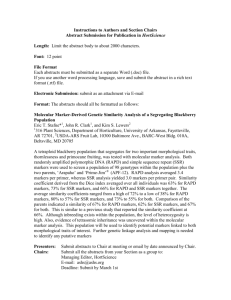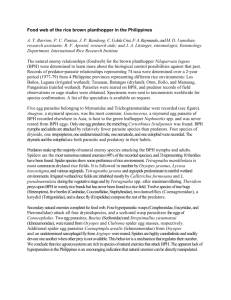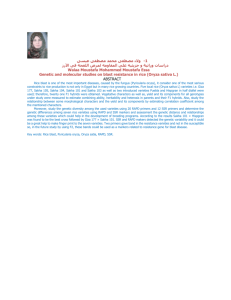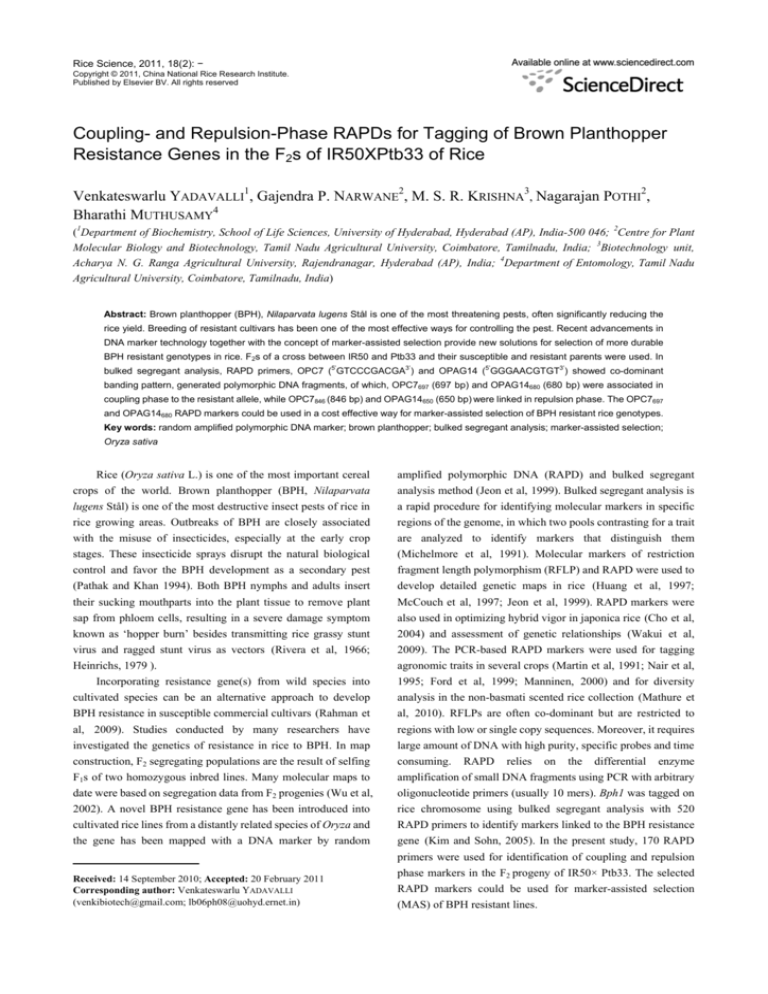
Rice Science, 2011, 18(2): −
Copyright © 2011, China National Rice Research Institute.
Published by Elsevier BV. All rights reserved
Coupling- and Repulsion-Phase RAPDs for Tagging of Brown Planthopper
Resistance Genes in the F2s of IR50XPtb33 of Rice
Venkateswarlu YADAVALLI1, Gajendra P. NARWANE2, M. S. R. KRISHNA3, Nagarajan POTHI2,
Bharathi MUTHUSAMY4
(1Department of Biochemistry, School of Life Sciences, University of Hyderabad, Hyderabad (AP), India-500 046; 2Centre for Plant
Molecular Biology and Biotechnology, Tamil Nadu Agricultural University, Coimbatore, Tamilnadu, India; 3Biotechnology unit,
Acharya N. G. Ranga Agricultural University, Rajendranagar, Hyderabad (AP), India; 4Department of Entomology, Tamil Nadu
Agricultural University, Coimbatore, Tamilnadu, India)
Abstract: Brown planthopper (BPH), Nilaparvata lugens Stål is one of the most threatening pests, often significantly reducing the
rice yield. Breeding of resistant cultivars has been one of the most effective ways for controlling the pest. Recent advancements in
DNA marker technology together with the concept of marker-assisted selection provide new solutions for selection of more durable
BPH resistant genotypes in rice. F2s of a cross between IR50 and Ptb33 and their susceptible and resistant parents were used. In
bulked segregant analysis, RAPD primers, OPC7 (5’GTCCCGACGA3’) and OPAG14 (5’GGGAACGTGT3’) showed co-dominant
banding pattern, generated polymorphic DNA fragments, of which, OPC7697 (697 bp) and OPAG14680 (680 bp) were associated in
coupling phase to the resistant allele, while OPC7846 (846 bp) and OPAG14650 (650 bp) were linked in repulsion phase. The OPC7697
and OPAG14680 RAPD markers could be used in a cost effective way for marker-assisted selection of BPH resistant rice genotypes.
Key words: random amplified polymorphic DNA marker; brown planthopper; bulked segregant analysis; marker-assisted selection;
Oryza sativa
Rice (Oryza sativa L.) is one of the most important cereal
crops of the world. Brown planthopper (BPH, Nilaparvata
lugens Stål) is one of the most destructive insect pests of rice in
rice growing areas. Outbreaks of BPH are closely associated
with the misuse of insecticides, especially at the early crop
stages. These insecticide sprays disrupt the natural biological
control and favor the BPH development as a secondary pest
(Pathak and Khan 1994). Both BPH nymphs and adults insert
their sucking mouthparts into the plant tissue to remove plant
sap from phloem cells, resulting in a severe damage symptom
known as ‘hopper burn’ besides transmitting rice grassy stunt
virus and ragged stunt virus as vectors (Rivera et al, 1966;
Heinrichs, 1979 ).
Incorporating resistance gene(s) from wild species into
cultivated species can be an alternative approach to develop
BPH resistance in susceptible commercial cultivars (Rahman et
al, 2009). Studies conducted by many researchers have
investigated the genetics of resistance in rice to BPH. In map
construction, F2 segregating populations are the result of selfing
F1s of two homozygous inbred lines. Many molecular maps to
date were based on segregation data from F2 progenies (Wu et al,
2002). A novel BPH resistance gene has been introduced into
cultivated rice lines from a distantly related species of Oryza and
the gene has been mapped with a DNA marker by random
Received: 14 September 2010; Accepted: 20 February 2011
Corresponding author: Venkateswarlu YADAVALLI
(venkibiotech@gmail.com; lb06ph08@uohyd.ernet.in)
amplified polymorphic DNA (RAPD) and bulked segregant
analysis method (Jeon et al, 1999). Bulked segregant analysis is
a rapid procedure for identifying molecular markers in specific
regions of the genome, in which two pools contrasting for a trait
are analyzed to identify markers that distinguish them
(Michelmore et al, 1991). Molecular markers of restriction
fragment length polymorphism (RFLP) and RAPD were used to
develop detailed genetic maps in rice (Huang et al, 1997;
McCouch et al, 1997; Jeon et al, 1999). RAPD markers were
also used in optimizing hybrid vigor in japonica rice (Cho et al,
2004) and assessment of genetic relationships (Wakui et al,
2009). The PCR-based RAPD markers were used for tagging
agronomic traits in several crops (Martin et al, 1991; Nair et al,
1995; Ford et al, 1999; Manninen, 2000) and for diversity
analysis in the non-basmati scented rice collection (Mathure et
al, 2010). RFLPs are often co-dominant but are restricted to
regions with low or single copy sequences. Moreover, it requires
large amount of DNA with high purity, specific probes and time
consuming. RAPD relies on the differential enzyme
amplification of small DNA fragments using PCR with arbitrary
oligonucleotide primers (usually 10 mers). Bph1 was tagged on
rice chromosome using bulked segregant analysis with 520
RAPD primers to identify markers linked to the BPH resistance
gene (Kim and Sohn, 2005). In the present study, 170 RAPD
primers were used for identification of coupling and repulsion
phase markers in the F2 progeny of IR50× Ptb33. The selected
RAPD markers could be used for marker-assisted selection
(MAS) of BPH resistant lines.
Rice Science, Vol. 18, No. 2, 2011
MATERIALS AND METHODS
Screening for BPH resistance
Screening for BPH resistance was done using the standard
seed box screening test in a green house, Paddy Breeding Station,
Coimbatore, India (Heinrichs and Mochida, 1984). The F2s from
the cross of IR50× Ptb33 were tested for their resistance to BPH
infestation. Taichung Native 1 (TN1) and Ptb33 served as the
susceptible and resistant check, respectively. Rice seedlings at
three-leaf (7 days after sowing) were infested with the 2nd–3rd
instar nymphs at 8 nymphs per seedling. When the seedlings of
the susceptible check were almost completely dead, the test
entries were rated according to the damage rating of the
Standard Evaluation System for rice (International Rice
Research Institute, 1996) (Table 1).
Isolation of genomic DNA
Isolation of genomic DNA was done following the method
recommended by Wu et al (2002) with slight modifications. To
extract DNA from the parents, the F2s from the scored plants, the
surviving plants immediately after screening were freed from
the insects and were planted in separate clay pots in order to
grow those to grown up stage for about 15–20 days so as to
extract sufficient quantity of DNA.
RAPD and bulked segregant analysis
RAPD analysis was performed following the method
described by Saiki et al (1988). A total of 73 decamer primers
obtained from Operon Technologies Inc., California, USA, were
used in this study. PCR was carried out in a total volume of 20
µL containing 10 ng of template DNA, 100 pmol primers, 0.5
mmol/L each of dNTPs, 0.5 U of Taq polymerase (Invitrogen)
and 1×PCR buffer containing 1.5 mmol/L MgCl2. PCR was
setup for initial denaturation at 95°C for 3 min, and then each
amplification cycle contained one denaturation step at 94°C for
1 min, annealing step at 36°C for 40 s, one extension step at
72°C and final extension is for three min at 72°C in a thermal
cycler (Eppendorf, USA). PCR amplification products were run
on 1.2% agarose gels containing 0.2 µg/mL ethidium bromide in
a standard horizontal gel electrophoresis unit (Broviga, Chennai,
Table 1. Standard evaluation system for rice brown planthopper
damage.
Scale
Criteria
0
1
3
None
Very slight damage
First and second leaves with orange tips;
slight stunting
More than half the leaves with yellow orange tips; pronounced stunting
More than half of the plants wilting or dead
and remaining plants severely stunted or
drying
All plants dead
5
7
9
Category
Highly resistant
Resistant
Moderately
resistant
Moderately
susceptible
Susceptible
Fig. 1. Frequency distribution of score ratings infested with N.
lugens on 170 F2 seedlings of IR50/Ptb33 based on the standard
evaluation system.
India) with TBE buffer (90 mmol/L Tris-borate, 1 mmol/L
EDTA, pH 8.0). The DNA bands were photographed in a gel
documentation system (AlphaImager). Initially, all 73 decamer
primers were used for parental screening on BPH-susceptible
IR50 and resistant Ptb33. Polymorphic primers were tested in
two DNA bulks and parents following Michelmore et al (1991).
RESULTS
Inheritance pattern of BPH resistance gene in F2 progeny
In a total of 170 F2s tested, the plants rated a damage score
of 1, 3 or 5 were grouped as resistant (130) and ones rated a
damage score of 7 or 9 were grouped as susceptible (40). This
data fitted well to the expected ratio of resistant against
susceptible at 3:1 (χ2 =0.19, P =0.97–0.99) (Fig. 1).
Identification of RAPD markers linked to BPH resistance
In parental screening, out of 73 primers used, 66 exhibited
DNA amplification. Out of five kits of RAPD operon primers
that were tested for parental polymorphism, OPAG series
primers showed maximum polymorphism (23.91%) between the
parents, IR50 and Ptb33 (Table 2). The polymorphism showed
by the RAPD primer series, OPC, OPE, OPAL and OPM were
found at 20.36%, 15.00%, 15.20% and 15.92%, respectively in
the parents IR50 and Ptb33. Among all these primers, two
co-dominant RAPD primers of OPC7 and OPAG14 were shown
distinct, repeatable and high degree of polymorphism in the
parents and bulks. OPC7 and OPAG14 were generated
polymorphic DNA fragments of which, OPC7697 (697 bp) and
OPAG14680 (680 bp) were associated with coupling phase to the
resistant allele, while OPC7846 (846 bp) and OPAG14650 (650 bp)
were linked to repulsion phase (Fig. 2 and Fig. 3).
DISCUSSION
The performance of the parents IR50, Ptb33 and the F2s
during screening revealed the consistency of the screening
Venkateswarlu YADAVALLI, et al. Coupling- and Repulsion-Phase RAPDs for Tagging
Table 2. Pattern of polymorphism between parents (IR50 and Ptb33) detected by RAPD analysis using operon primers.
Sl. No.
1
2
3
4
5
Polymorphic primer
OPC series
OPE series
OPAL series
OPM series
OPAG series
Total
IR50
113
141
62
72
33
426
No. of bands
Ptb33
108
130
61
87
56
442
Total
221
271
128
159
89
868
Monomorphic band
No.
%
178
80.54
238
85.00
104
83.20
114
87.69
70
76.08
704
Polymorphic band
No.
%
45
20.36
42
15.00
19
15.20
25
15.92
22
23.91
153
Fig. 2. Co-segregation banding pattern of the RAPD primer OPC7 DNA fragment, OPC7697 (697 bp) was associated in coupling phase to the
resistant allele, while OPC7846 (846 bp) was in repulsion phase.
M, Marker; RP, Resistant parent; RB, Resistant bulk; SP, Susceptible parent; SB, Susceptible bulk.
Fig. 3. Co-segregation banding pattern of the RAPD primer OPAG14 DNA fragment OPAG14680 (680 bp) were associated in coupling phase to
the resistant allele, while OPAG14650 (650 bp) was in repulsion phase.
M, Marker; RP, Resistant parent; RB, Resistant bulk; SP, Susceptible parent; SB, Susceptible bulk.
protocols (SES, 1996) for BPH resistance in this study.
Phenotypic evaluation should be performed with more reliable
methods to avoid false positives in further MAS (Machill and Ni,
2001). DNA amplification products obtained from PCR analysis
using random primers has been proposed as an alternative
method in targeting DNA sequences for genetic characterization
and mapping (Williams et al, 1990). Relatively higher number
of amplified products per primer was found in rice, when
compared to other plants, like maize (Welsh and McClelland,
1990). One of the most time consuming requirements of DNA
marker development, is the need to screen entire mapping
populations, with every probe or primer and this has been
removed by the bulked segregant analysis. The minimum size of
a bulk is determined by the frequency with which linked loci
might be detected as polymorphic between the bulked samples.
OPC7 and OPAG14 were generated polymorphic DNA
fragments of which, OPC7697 (697 bp) and OPAG14680 (680 bp)
were associated in coupling phase to the resistant allele, while
OPC7846 (846 bp) and OPAG14650 (650 bp) were linked in
repulsion phase (Fig. 2 and Fig. 3). Two pools contrasting for a
trait of BPH susceptibility were analyzed to identify markers
that distinguish them. The polymorphic markers between the
pools will be genetically linked to the loci that determine the trait
was used to construct the pools (Michelmore et al, 1991).
Results obtained in F2 seedlings indicate that RAPD markers are
co-dominant, highly polymorphic and informative in nature.
These co-dominant RAPD markers are comparatively unique.
Similar to other kinds of co-dominant markers, these co-dominant
RAPD markers can be of particular value for the purpose of
linkage analysis because they provide maximum linkage
information per individual in the segregating populations.
Co-dominant markers provide easy discrimination between
Rice Science, Vol. 18, No. 2, 2011
recombinant homozygotes and recombinant heterozygotes
(Williams et al, 1990; Mohan et al, 1997; Semagn et al, 2006).
So far, co-dominant RAPD markers have been successfully
employed in MAS in various crops (Mondal et al, 2007).
A clear polymorphism between the bulks in comparison
with the parents was observed. Poulson et al (1995) suggested
that bulked segregant analysis can be robust to cope with the low
level of phenotypic misclassification when bulks are constructed
with good size of individuals. Bulked segregant analysis using
RPAD markers were successfully used in the development of
linked molecular markers. Thus, RAPD markers OPC7697 and
OPAG14680 could be used in a cost effective way for MSA of
BPH-resistant rice genotypes.
ACKNOWLEDGEMENT
We sincerely acknowledge Department of Biotechnology,
Government of India, for providing financial assistance. Dr. K.
Prabhakara RAO, Scientist, CTRI, Rajahmundary (AP) for
improving the manuscript and reviewers for suggesting the
better presentation of this article.
REFERENCES
Cho Y I, Park C W, Kwon S W, Chin J H, Ji H S, Park K J,
McCouch S, Koh H J. 2004. Key DNA markers for predicting
heterosis in F1 hybrids of japonica rice. Breeding Sci, 54:
389–397.
Ford R, Pang E C K, Taylor P W J. 1999. Genetics of resistance to
ascochyta blight (Ascochyta lentis) of lentil and the identification
of closely linked RAPD markers. Theor Appl Genet, 98: 93–98.
Heinrichs E A. 1979. Control of leafhopper and planthopper vectors
of rice viruses. In: Moramorosch K, Arris K F . Leafhopper
Vectors and Planthopper Disease Agents. New York: Academic
Press: 529–558.
Heinrichs E A, Mochida O. 1984. From secondary to major pest
status: The case of insectcticide-induced rice brown planthopper,
Nilaparvata Lugens resurgence. Prot Ecol, 7: 201–218.
Huang N, Arnold P, Mew T, Magpantay G, McCouch S, Guiderdoni
E, Xu J, Subudhi P, Angeles R, Khush G S. 1997. RFLP mapping
of isozymes, RAPD and QTLs for grain shape, brown
planthopper resistance in a doubled haploid rice population. Mol
Breeding, 1: 1–8.
International Rice Research Institute. 1996. Standard Evaluation
System for Rice. Manila, Philippines: International Rice Research
Institute.
Jeon Y H, Ahn S N, Choi H C, Hahn T R Moon H P. 1999. A RAPD
marker for the gene conferring resistance to Indian biotype of
BPH. Rice Genet Newsl, 15: 133–134.
Kim S M, Sohn J K. 2005. Identification of a rice gene (Bph1)
conferring resistance to brown planthopper (Nilaparvata lugens
Stål) using STS markers. Mol Cells, 20: 30–34.
Machill D J, Ni J. 2001. Molecular mapping and marker assisted
selection for major gene traits in rice. In: Khush G S, Brar D S,
Hardy B. Rice genetics IV. IRRI, Philippines Science Publishers,
Inc: 137–146.
Manninen O M. Associations between anther-culture response and
molecular markers on chromosomes 2H, 3H and 4H of barley
(Hordeum vulgare L.). Theor Appl Genet, 2000, 100: 57–62.
Martin G B, Williams J G K, Tanksley S D. 1991. Rapid
identification of markers linked to a Pseudomonas resistance gene
in tomato by using random primers and near isogenic lines. Proc
Natl Acad Sci USA, 88: 2336–2340.
Mathure S, Jawali N, Nadaf A. 2010. Diversity analysis in selected
non-basmati scented rice collection. Rice Sci, 17: 35–42.
McCouch S R, Chen X, Panaud O, Temnykh S, Xu Y, Cho Y G,
Huang N, Ishii T, Blair M. 1997. Microsatellite marker
development, mapping and applications in rice genetics and
breeding. Plant Mol Biol, 35: 89–99.
Michelmore R, Paran W I, Kesseli R V. 1991. Identification of
markers linked to disease resistance genes by bulked-segregant
analysis: A rapid method to detect markers in specific genome
regions by using segregating populations. Proc Natl Acad Sci
USA, 88: 9828–9832.
Mohan M, Nair S, Baghwat A, Krishna T G, Yano M, Bhatia C R,
Sasaki T. 1997. Genome mapping, molecular markers and
marker-assisted selection in crop plants. Mol Breeding, 3:
87–103.
Mondal S, Badigannavar A M, Murty G S S. 2007. RAPD markers
linked to a rust resistance gene in cultivated groundnut (Arachis
hypogaea L.). Euphytica, 159: 233–239.
Nair S, Bentur J S, PrasadaRao U, Mohan M. 1995. DNA markers
tightly linked to a gall midge resistance gene (Gm2) are
potentially useful for marker-aided selection in rice breeding.
Theor Appl Genet, 91: 68–73.
Poulson D M E, Henry R J, Johnston R P, Irwin J A G, Rees R G.
1995. The use of bulk segregant analysis to identify a RAPD
marker linked to leaf rust resistance in barley. Theor Appl Genet,
91: 270–273.
Rahman M L, Jiang W, Chu S H, Qiao Y, Ham T H, Woo M O, Lee
J, Khanam M S, Chin J H, Jeung J U, Brar D S, Jena K K, Koh H
J. 2009. High-resolution mapping of two rice brown planthopper
resistance genes, Bph20(t) and Bph21(t), originating from Oryza
minuta. Theor Appl Genet, 119: 1237–1246.
Rivera C T, Ou S H, Lida T T. 1966. Grassy stunt disease of rice and
its transmission by Nilaparvata lugens (Stål). Plant Dis Rep, 50:
453–456.
Saiki R K, Gelfand D H, Stoffel S, Scarf S J, Higuchi R, Horn G T,
Mullis K B, Erlich H A. 1988. Primer directed enzymatic
amplification of DNA with a thermostable DNA polymerase.
Science, 239: 487–491.
Semagn K, Bjørnstad Å, Ndjiondjop M N. 2006. Principles,
requirements and prospects of genetic mapping in plants. Afr J
Biotechn, 5: 2569–2587.
Wakui K, Iwata H, Takahashi Y, Takahata Y, Fujigaki J. 2009.
Assessment of the congruity of genetic relationships and variation
revealed by individual- and bulked-samples-based approaches
using RAPD and ISSR markers in Japanese turnip (Brassica rapa
ssp. rapa) cultivars. Breeding Sci, 59: 447–452.
Welsh J, McClelland M. 1990. Fingerprinting of genomes using
PCR with arbitrary primers. Nucl Acid Res, 18: 7213–7218.
Williams J G K, Kubelik A R, Livak K J, Rafalski J A, Tingey S V.
1990. DNA polymorphisms amplified by arbitrary primers are
useful as genetic markers. Nucl Acids Res, 18: 6531–6535.
Wu J Y, Wu H K, Chung M C. 2002. Co-dominant RAPD markers
closely linked with two morphological genes in rice (Oryza sativa
L.). Bot Bull Acad Sin, 43: 171-180.

